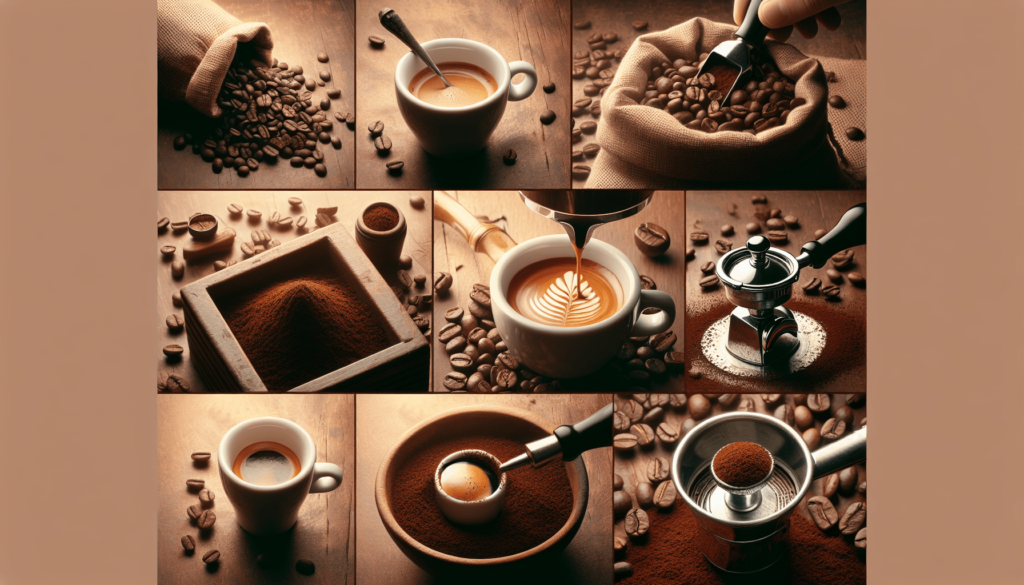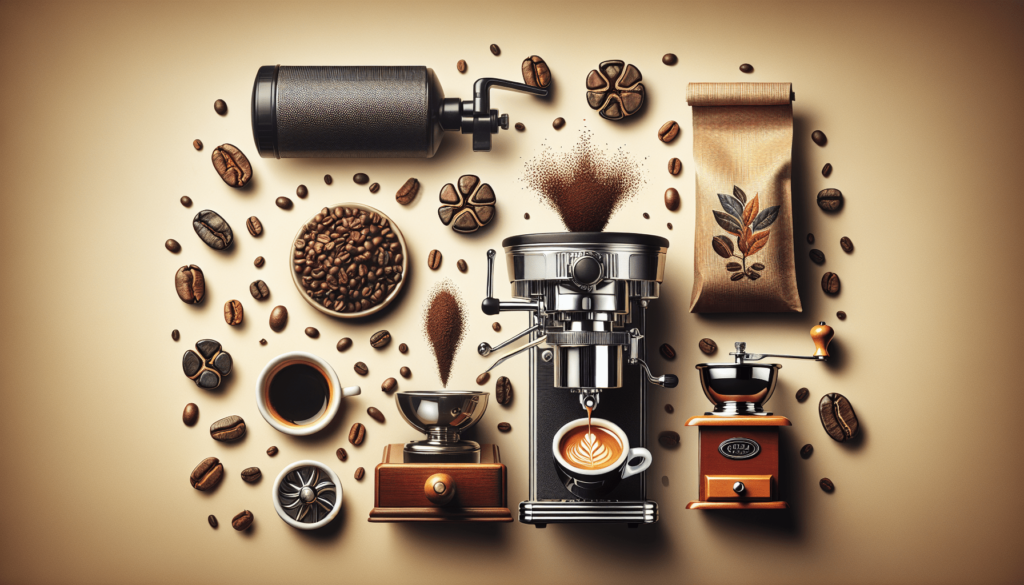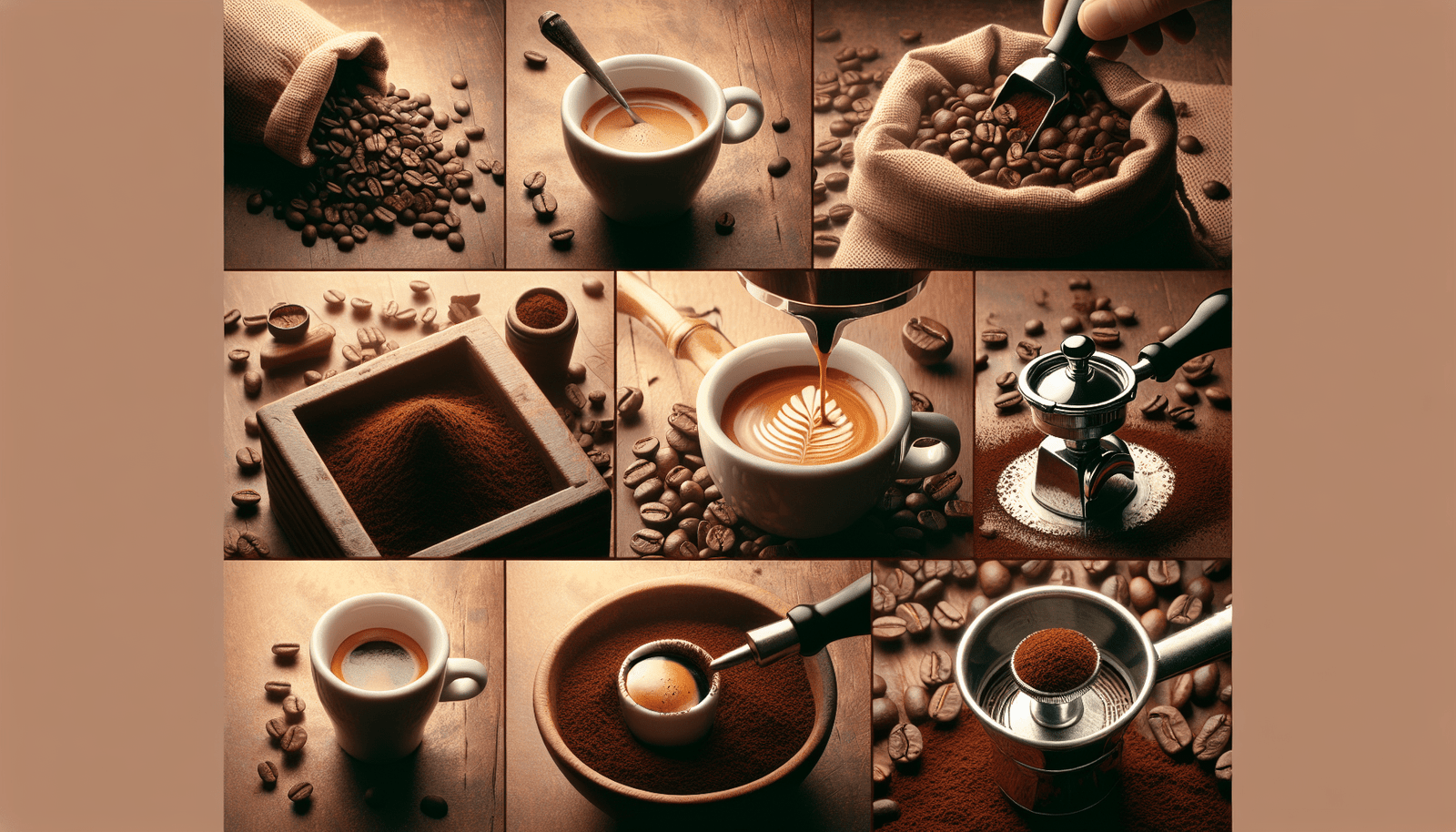Are you tired of mediocre cups of coffee? If you’re ready to elevate your coffee game and experience the true flavors and aromas of a perfectly brewed espresso, then look no further. This ultimate guide is here to help you master the art of brewing espresso with whole beans. From selecting the right beans to achieving the perfect grind, we’ll walk you through every step to ensure you indulge in a rich and satisfying coffee experience. Say goodbye to average coffee and say hello to your new favorite drink. Let’s get started!

Choosing the Right Beans
Understanding the Different Types of Beans
When it comes to brewing espresso, the choice of beans plays a crucial role in determining the flavor and quality of your cup. There are several different types of beans to choose from, including Arabica, Robusta, and blends. Arabica beans are known for their delicate and nuanced flavors, while Robusta beans are bolder and more robust in taste. Blends, on the other hand, offer a combination of both types, providing a well-balanced and complex flavor profile. Understanding the differences between these bean types will help you make an informed decision based on your personal taste preferences.
Evaluating Bean Quality
Once you’ve decided on the type of beans you want to use, it’s important to evaluate their quality. A good-quality bean will have a uniform shape, without any significant defects or blemishes. Look for beans that are evenly colored and have a shiny appearance. Avoid beans that have a dull appearance or any signs of mold or damage. Additionally, consider the roast date of the beans. Fresher beans tend to have more vibrant flavors, so opt for beans that have been roasted within the last couple of weeks for the best results.
Determining Roast Level
The roast level of your beans is another crucial aspect to consider. The roast level not only impacts the flavor of your espresso but also affects the brewing process. Lighter roasts tend to have a brighter and more acidic flavor profile, while darker roasts are richer and have a more pronounced bitterness. It’s important to experiment with different roast levels to find the one that suits your taste preferences. Keep in mind that the roast level can also affect the grind size, extraction time, and overall brewing process, so choose accordingly.
Grinding the Beans
Investing in a Good Grinder
To achieve the perfect shot of espresso, investing in a good grinder is essential. A quality grinder will allow you to grind your beans consistently and evenly, ensuring a uniform extraction and optimal flavor. Burr grinders are highly recommended for espresso brewing, as they provide a more precise grind size and minimize heat transfer, preserving the delicate flavors of the beans. Avoid blade grinders if possible, as they tend to produce inconsistent grind sizes.
Choosing the Right Grind Size
The grind size of your coffee beans is another critical factor in brewing espresso. Different brewing methods require different grind sizes, and for espresso, a fine grind is necessary. The fine grind allows for a slower extraction and helps to create a concentrated and rich flavor in your espresso shot. However, it’s important not to grind the beans too fine, as this can result in over-extraction and a bitter taste. Aim for a grind size that resembles granulated sugar or fine sand.
Maintaining Consistency
Consistency is key when it comes to grinding your beans for espresso. Ensure that your grinder is set to the same grind size each time you brew to maintain a consistent extraction. Inconsistent grind sizes can result in uneven extraction, leading to variations in flavor and quality. As you experiment with different beans and roast levels, take note of the optimal grind size for each, so you can replicate the results consistently.
Measuring Ratios
Understanding the Golden Ratio
When brewing espresso, finding the perfect balance between coffee and water is crucial. This balance is often referred to as the golden ratio. The golden ratio for espresso is generally considered to be 1:2, which means using one part coffee to two parts water. However, this ratio can be adjusted according to personal preference. Some individuals prefer a stronger espresso and may choose to increase the coffee-to-water ratio, while others may prefer a milder taste and opt for a more diluted ratio.
Using Digital Scales
To achieve consistency and accuracy in your espresso brewing, using digital scales is highly recommended. Digital scales allow you to measure the precise amount of coffee and water, eliminating any guesswork and ensuring that you maintain the desired ratios. This level of precision is particularly important for espresso, as even slight variations in ratios can significantly impact the flavor and quality of your shot.
Adjusting Ratios for Personal Preference
While the golden ratio provides a good starting point, it’s important to adjust the ratios according to your personal taste preferences. If you find that your espresso is too strong or too weak, you can easily tweak the ratio by adding more or less coffee or water. Remember to make small adjustments and taste the results before making any significant changes. This way, you can gradually fine-tune the ratio to create the perfect cup of espresso that suits your individual taste.
Water Temperature and Quality
Importance of Having the Right Water Temperature
The water temperature used in brewing espresso plays a crucial role in extracting the desired flavors from the coffee beans. The ideal water temperature for brewing espresso is between 195°F and 205°F (90°C and 96°C). Water that is too hot can lead to over-extraction and a bitter taste, while water that is too cold can result in under-extraction, producing a weak and sour cup of espresso. Investing in a good espresso machine with temperature control features can help ensure that you consistently achieve the optimal water temperature.
The Role of Water Quality in Espresso Extraction
Not only is water temperature important, but the quality of the water you use can also affect the extraction process. Using filtered or bottled water is recommended, as it helps to minimize any impurities or minerals that can alter the taste of your espresso. Tap water, especially if it is hard or has a strong taste, can negatively impact the flavors in your espresso. By using high-quality water, you can enhance the overall taste and aroma of your espresso.
Achieving Optimal Water Temperature
To ensure that you achieve the optimal water temperature, it’s essential to preheat your espresso machine properly. Preheating helps to bring the machine up to the desired temperature, ensuring that the water that comes into contact with the coffee grounds is hot enough for extraction. Follow the manufacturer’s instructions for preheating your specific espresso machine model, as the process may vary. Preheating will help you consistently achieve the ideal water temperature for the best possible espresso extraction.

Mastering the Espresso Machine
Understanding the Different Components
To become a master espresso brewer, it’s important to have a good understanding of the different components of your espresso machine. Familiarize yourself with the machine’s water reservoir, boiler, portafilter, and group head. Understanding how these components work together will help you control the brewing process more effectively and make any necessary adjustments to achieve optimal results.
Preheating the Machine
As mentioned earlier, preheating the espresso machine is crucial for achieving the proper water temperature during extraction. Preheating also helps to stabilize the temperature throughout the brewing process, reducing any fluctuations that can impact the taste of your espresso. Make sure to give your machine enough time to preheat fully before you begin brewing. This will help ensure consistency and maximize the flavors in your espresso shot.
Calibrating the Pressure
The pressure used during the espresso extraction process is another vital aspect to master. Most espresso machines have a built-in pump that controls the pressure, typically ranging between 9 and 15 bars. It’s important to understand how to calibrate the pressure according to your bean variety, grind size, and personal taste preferences. Adjusting the pressure can help achieve better extraction and balance the flavors in your espresso shot.
Tamping Technique
Importance of Tamping
Tamping refers to the process of packing the coffee grounds evenly and firmly in the portafilter. Proper tamping is crucial for achieving an even extraction and creating a smooth and balanced espresso shot. Tamping helps to create resistance against the water flow, ensuring that the water is forced to pass through the coffee grounds, extracting the desired flavors and oils. Without proper tamping, you may experience channeling, uneven extraction, and inconsistent flavor profiles.
Mastering Tamping Pressure
The pressure applied during tamping is equally important as the grind size and evenness of the coffee bed. The ideal tamping pressure is firm and even, without using excessive force. Applying too much pressure can lead to over-extraction, while too little pressure can result in under-extraction. The key is to find the balance that allows for the water to flow through the coffee evenly, extracting the flavors without causing any channeling or unevenness. Practice tamping with a bathroom scale or a dedicated tamper pressure gauge to achieve consistent results.
Achieving a Level Surface
In addition to tamping pressure, achieving a level surface on the coffee bed is essential for effective extraction. Uneven surfaces can lead to irregular extraction, resulting in inconsistent flavors. After tamping, check the surface of the coffee bed by gently tapping the sides of the portafilter. If necessary, use your finger or a tamping mat to even out the surface, ensuring a smooth and level bed of coffee. This will help create a uniform water flow and enhance the overall extraction process.
Extraction Time and Shot Volume
Determining Ideal Extraction Time
The extraction time refers to the duration it takes for water to pass through the coffee bed in the portafilter. The ideal extraction time for espresso is typically between 25 and 30 seconds. This time frame allows for a balanced extraction, extracting the desired flavors and oils from the coffee beans without over-extracting and causing bitterness. Keep in mind that the extraction time can vary depending on factors such as grind size, coffee variety, and personal preference. Experiment with different extraction times to find the one that produces the best-tasting espresso for you.
Controlling Shot Volume
Shot volume refers to the amount of espresso produced during extraction. The standard shot volume is typically around 30 milliliters, but this can be adjusted according to personal preference. Some individuals prefer a larger shot volume, while others opt for a smaller, more concentrated shot. It’s important to note that shot volume directly impacts the extraction time, so adjusting the dose and grind size accordingly is necessary to maintain the desired flavors and balance in your espresso shot.
Achieving Balanced Flavors
The key to achieving balanced flavors in your espresso shot lies in finding the sweet spot between extraction time and shot volume. A well-extracted espresso should have a balance of sweetness, acidity, and bitterness. By experimenting with different extraction times and shot volumes, you can adjust the flavors according to your taste preferences. Take note of the combinations that produce the best balance and fine-tune your brewing process to consistently achieve the desired flavor profile.
Correcting Common Issues
Identifying Under- or Over-Extraction
Under- or over-extraction is a common issue when brewing espresso, but it can be corrected by making adjustments to the grind size. If your espresso tastes weak or sour, it may be under-extracted, indicating that the water did not extract enough flavors from the coffee grounds. In this case, try using a finer grind to increase the extraction and increase the contact time between water and coffee. On the other hand, if your espresso tastes bitter or astringent, it may be over-extracted, indicating that the water extracted too much from the coffee grounds. To resolve this, try using a coarser grind to reduce the extraction time and decrease the contact time between water and coffee.
Adjusting Grind Size to Fix Imbalances
In addition to correcting under- or over-extraction, adjusting the grind size can also help to fix imbalances in the flavors of your espresso. If your espresso tastes too acidic, a finer grind can help to reduce the acidity and bring out more sweetness. Conversely, if your espresso tastes too bitter or lacks complexity, a coarser grind can help to reduce the bitterness and enhance the overall flavors. Fine-tuning the grind size can significantly impact the taste and quality of your espresso, so don’t be afraid to experiment and make adjustments accordingly.
Troubleshooting Bitter or Sour Tastes
If your espresso consistently tastes bitter or sour, there are a few troubleshooting steps you can take. Firstly, check the freshness of your beans. Beans that are past their prime can produce off-flavors and result in a less enjoyable cup of espresso. Secondly, ensure that your water temperature is within the optimal range. As discussed earlier, water that is too hot or too cold can impact the flavors of your espresso. Finally, review your extraction time and shot volume. Adjusting these factors can help to achieve a more balanced flavor profile and resolve any issues with bitterness or sourness.
Milk Steaming and Latte Art
Choosing the Right Milk
If you enjoy milk-based espresso drinks such as lattes and cappuccinos, choosing the right milk is essential. Whole milk is a popular choice for its creamy and rich texture, which complements the flavors of espresso. However, if you prefer a lighter option, you can also use low-fat or non-dairy alternatives like almond, soy, or oat milk. Each type of milk will add its own unique flavor and texture to your drink, so experiment with different options to find the one that suits your taste preferences.
Steaming Milk to Achieve the Perfect Texture
Steaming milk is an art in itself and plays a crucial role in creating the perfect texture for your milk-based espresso drinks. The key is to create small and fine bubbles by introducing air into the milk while simultaneously heating it. Start with cold milk and place the steam wand just below the surface, positioning it at a slight angle to create a swirling motion. As the milk heats up, gradually lower the steam wand to maintain the proper position for incorporating air. The end result should be smooth, silky milk with a velvety texture that enhances the overall taste and presentation of your espresso beverage.
Basic Latte Art Techniques
Latte art is a beautiful way to showcase your barista skills and impress your friends and family. While mastering latte art takes time and practice, there are a few basic techniques that you can start with. The most common latte art design is the heart, which is created by pouring a steady stream of milk into the center of the espresso shot and then moving the pitcher back and forth to create the shape. Another popular design is the rosetta, which involves pouring the milk in a continuous, back-and-forth motion while slowly moving the pitcher from one side to the other. With practice and patience, you can create intricate and visually stunning latte art designs that will elevate your espresso brewing experience.
Cleaning and Maintenance
Regular Cleaning Practices
To ensure that your espresso machine and grinder function optimally and produce the best-tasting espresso, regular cleaning is essential. After each use, make it a habit to rinse the portafilter, steam wand, and group head to remove any coffee residue. Additionally, wipe down the exterior of the machine with a damp cloth to prevent any buildup of grime or oils. Regular cleaning not only keeps your espresso equipment hygienic but also helps to maintain the flavor integrity of your espresso shots.
Deep Cleaning the Espresso Machine
In addition to regular cleaning, it’s important to perform deep cleaning on your espresso machine at regular intervals. This involves descaling the machine to remove any mineral deposits that can accumulate over time and impact the performance of the machine. Follow the manufacturer’s instructions for descaling, as the process may vary depending on your specific espresso machine model. Deep cleaning should be done every few months or as recommended by the manufacturer to ensure that your espresso machine continues to operate efficiently and produce high-quality espresso.
Maintaining the Grinder
Just like your espresso machine, your grinder also requires regular maintenance to deliver consistent and high-quality results. Cleaning the grinder burrs and removing any coffee oils and residue is crucial for maintaining the grinder’s performance. Consult the manufacturer’s instructions for proper cleaning and maintenance procedures, as these can vary depending on the grinder model. By keeping your grinder clean and well-maintained, you can ensure a consistent and precise grind size, leading to better extraction and a more enjoyable espresso experience.
In conclusion, brewing espresso with whole beans is truly an art form that requires knowledge, skill, and practice. By understanding the different types of beans, evaluating their quality, and determining the appropriate roast level, you can set the foundation for a great espresso. Investing in a good grinder, understanding grind size, and maintaining consistency will further enhance the brewing process. Measuring the coffee-to-water ratio accurately, optimizing water temperature and quality, and mastering the espresso machine’s components are essential for achieving the perfect extraction. Tamping techniques, adjusting extraction time and shot volume, and correcting common issues will help you fine-tune your espresso brewing skills. Additionally, understanding milk steaming, basic latte art techniques, and implementing proper cleaning and maintenance practices will elevate your espresso experience even further. With dedication and a passion for crafting the perfect cup, you can become a master espresso brewer and savor the rich flavors and aromas of freshly brewed espresso.

